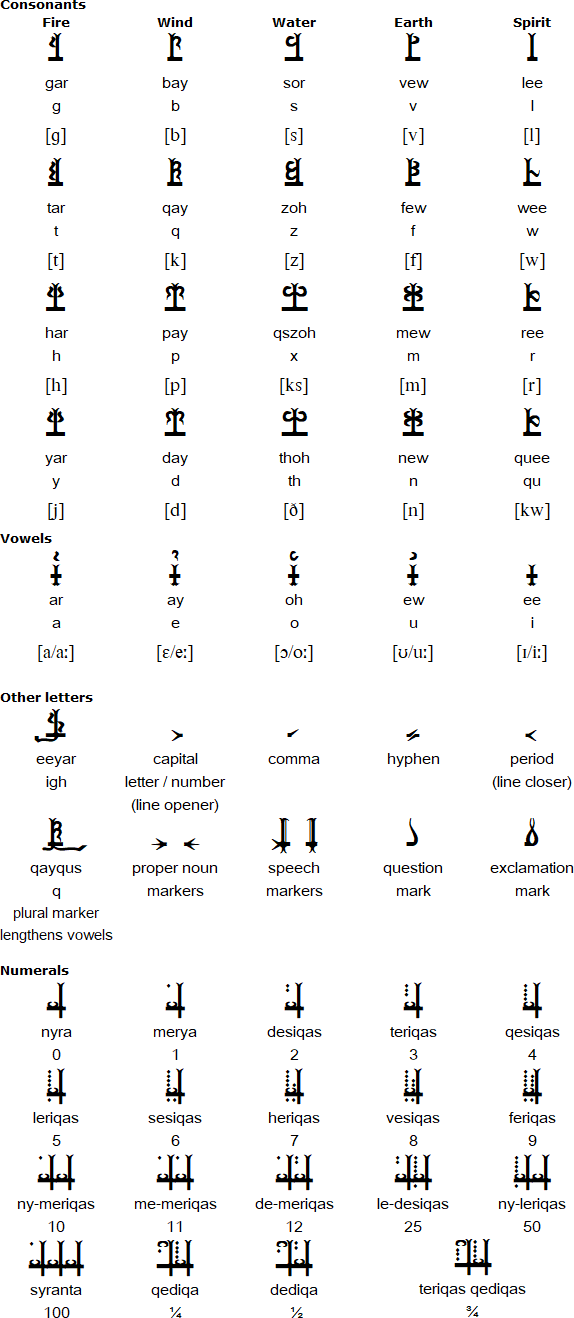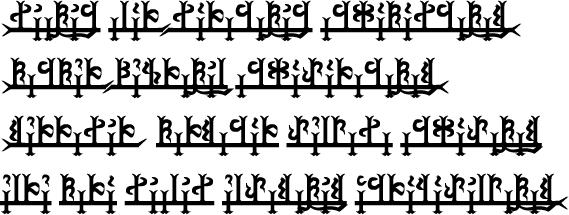The Qahmaniyan script and the Quensian language were created in stages between 2010 and 2020 by S. Hawley as part of world building idea for a fantasy novel. The novel got shelved as life and a lack of inspiration got in the way. However, the language continued to develop and grow as the years went by. Some of the context of what had been envisaged is detailed below.
The Qahmaniyan script takes its name from two routes. Firstly, the Quensian word 'qahma' means 'nature' – as seen in the shape and forms of the letters (more on this below).
Secondly, the Quensian language forms part of the Qahmani-Quensian group of languages. The two rival empires; Qahmaniyah (literally: "the natural ones or children of nature") versus the Quensians.
Several hundred years earlier the two empires had been conjoined as a reluctant dual monarchy, with the Qahmaniyans holding the balance of power. A key outcome of this was a large influx of imported words and phrases into Quensian and also the idea of the alphabet and its form based upon nature – hence the name of the script.
The irony being is that the name of the script is not only a foreign import word, from a rival empire but it also retains the donor language's long vowels and thus doesn't follow the pronunciation rules for Quensian.
The Quensian language has its major phonic influence from Latin, primarily seen in the noun cases and their endings, which clearly echo the ancient language. Likewise the word order owes some of its traits to Latin, but also some to English. The vocabulary however, with the exception of perhaps a few words which are similar to Latin (particularly a few of the colours) is markedly different in most respects. The actual grammatical rules beyond the nouns and their cases are also very different.
The language is heavily reliant upon short vowels.
Long vowels (with one exception) are not distinguished by their own alphabetic symbols. They are mostly triggered (or tripped – as the Quensians would term it) by certain vowel/consonant combinations – as in English e.g. the 'a' in 'cat' compared to 'ah' in 'car'.
Long vowels also appear as a product of pluralisation, the 'plural –q', always tripping the preceding 'i' to fall long. The 'plural -q' has its own symbol.
Some conjunctions/prepositions also feature terminal long vowels (terminal 'e' is particularly prevalent) – these are also unmarked.
The letter 'y' can be either consonantal (with the clear cut 'y' sound of yet or a blended 'igh-y' sound as in higher) OR it can be used as a vowel where it is a pure 'igh' sound. These two variants though are marked by separate letters.
One sound - 'th'is used only to mark diminutives e.g.
English sounds: 'sh', 'ch' and 'j' do not exist in Quensian and while 'w' does exist, it is rare.
The script is alphabetic and is based upon the elements of nature. The letters are formed from one of the following; flames for fire, breezes for wind, waves for water, hills (or trees) for land and finally either a 'river' or an 'absence of marks' for the spiritual. These latter marks depict either the river of life or the intangible nature of being.
All of the consonants and vowels are based around the 'skeleton' letters 'i' and 'l' – the principle being that in the same way that language brings life to ideas and stories, the spiritual essence brings life to the alphabet and thus to its sounds.
The letters are tied to a horizontal bar known as a keel. In the past, each word was thought of as a ship sailing the seas (the individual letters being its complement of masts and oars). A full sentence was seen therefore as a fleet of ships.
The capital letters open the sentence keel with a '>' shaped mark, and a period closes the sentence with a mirror image '<'. Other punctuation exists and generally breaks the keel in a variety of ways.
In manuscripts, capitalisation was sometimes marked in red. In contrast to English, the periods or commas are always placed after speech marks so that the final word's keel isn't broken.
Proper nouns are marked with their own special trident openers and closers and the whole word was also sometimes written in red.
The numeral system has a simplistic origin, which developed from counting on fingers.
The pictograms are arranged so that there is a counting cup where an amount is placed (conversely, some sources claim it to be the bird's eye view of a man counting on his fingers).
Nevertheless, the dots work in sequence, as counting on fingers when palms are face down. Starting at the top with a dot for the little finger of the left hand and working down towards the thumb. The finger dots are placed above the baseline and the thumb dots are placed below.
Although written using standard place value as we know it, when counting, the numbers are reversed compared to English and act like German or Latin in that they state: One and Twenty (or more specifically One-Two) and never Twenty One.
Fractions are formed by two numbers. The first with a cup inverted and a number falling from it (i.e. literally what is taken out) and the second the usual way around with the total that it is taken from. So ¼ is iterated literally as 'one from a group of four'.

Download an alphabet chart for Qahmaniyan (Excel)
Download a font for Qahmaniyan

Nuiqus ilar-narisiqus ismaqansiqit. Qisqer-feyriqul ismadarisiqit. Terrinur, qirtisar delbini ismadiqit elre qira nuilun elditiqut osragadulbiqit.
Men all-free they are born. In dignity-Rights they are equal. Reason, conscience given they are and the spirit of mankind others they ought to have towards.
All human beings are born free and equal in dignity and rights. They are endowed with reason and conscience and should act towards one another in a spirit of brotherhood.
(Article 1 of the Universal Declaration of Human Rights)
See some idioms in Quensian (PDF)
Longer sample text (Tower of Babel)
Constructed scripts for: Ainu | Arabic | Chinese languages | Dutch | English | Hawaiian | Hungarian | Japanese | Korean | Lingala | Malay & Indonesian | Persian | Tagalog / Filipino | Russian | Sanskrit | Spanish | Taino | Turkish | Vietnamese | Welsh | Other natural languages | Colour-based scripts | Tactile scripts | Phonetic/universal scripts | Constructed scripts for constructed languages | Adaptations of existing alphabets | Fictional alphabets | Magical alphabets | A-Z index | How to submit a constructed script
[top]
You can support this site by Buying Me A Coffee, and if you like what you see on this page, you can use the buttons below to share it with people you know.

If you like this site and find it useful, you can support it by making a donation via PayPal or Patreon, or by contributing in other ways. Omniglot is how I make my living.
Note: all links on this site to Amazon.com, Amazon.co.uk
and Amazon.fr
are affiliate links. This means I earn a commission if you click on any of them and buy something. So by clicking on these links you can help to support this site.
[top]